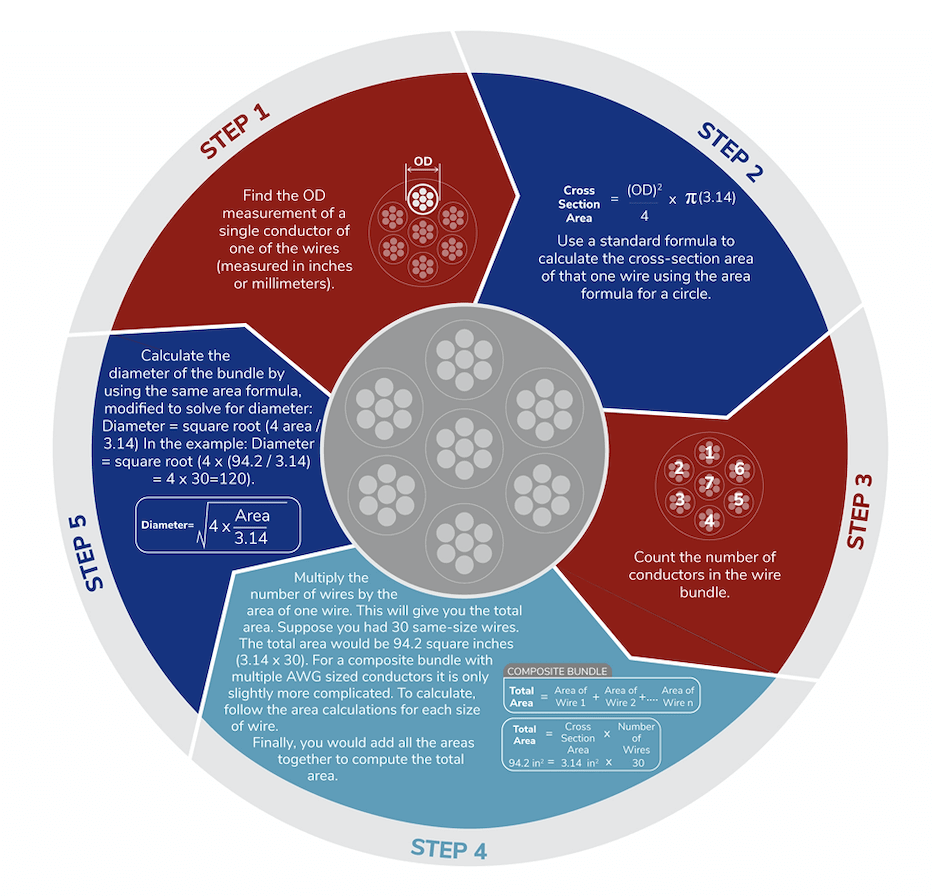5 Steps to Calculate the Diameter of Bundled Cable

Download our infographic on calculating the diameter of bundled cable
One of the requests we frequently receive is to include an overall diameter (OD) of the customized cable bundles being quoted. This request comes up often since electrical contractors need to be able to estimate if their plans are in sync with one another, and a ballpark estimate gives them a sense that their initial assumptions and calculations are correct, or if they want to add a little margin of error in the costs of the conduit, or if they really have to crunch the numbers to ensure everything fits within the National electrical code (NEC) standards.
As an OEM that reprocesses premanufactured wire, we do not make the wire itself, and each manufacturer has its own tolerances in terms of OD for each wire jacket type.
Here we use averages of manufacturer specs to give us the ability to estimate the OD of the wire bundle for our own necessary calculations which is reel capacity. The calculation itself is a matter of mathematics, and with known data can be formulated and calculated using simple excel spreadsheets.
This calculation helps determine if the conduit planned is the correct size or not. The easiest way to actually measure the cable bundle is with a small measuring tool called an OD-Tape. OD-Tapes are used in the electrical field and plumbing fields to measure both length and overall outside diameter. To estimate the bundle, cut one 3-inch piece for each conductor in your bundle, tape them all together and use the OD tape to measure the outside.
Calculating the diameter might be as easy as measuring it using a more involved mathematical approach.
Here are 5 steps:
1. Find the OD measurement of a single conductor of one of the wires. This measurement will probably be in inches or millimeters.
2. Utilize a standard formula to calculate the cross-section area of that one wire using the area formula for a circle, i.e., area equals the square of the diameter multiplied by 3.14 (pi) divided by four. As an example, a 2-inch wire would have an area of 3.14 square inch because 2 x 2 x 3.14 divided by 4 = 3.14.
3. Count the number of wires in the bundle.
4. Multiply the number of wires by the area of one wire. This will give you the total area. To continue the example, suppose you had 30 same-size wires. The total area would be 94.2 square inches (3.14 x 30). This example would be for a bundle of the same sized wires in the bundle. For a composite bundle with multiple AWG sized conductors it is only slightly more complicated. To calculate you simply follow the area calculations for each size of wire, that is, calculate one wire’s area and multiply it by the number of equal-sized wires (so if #14 is 10 wires then multiply the OD by 10; If #12 is 20 then multiply the OD by 20). Finally, you would add all the areas together to compute the total area.
5. Calculate the diameter of the bundle by using the same area formula, modified to solve for diameter: Diameter = square root (4 area / 3.14) In the example: Diameter = square root (4 x (94.2 / 3.14) = 4 x 30=120)
Diameter = square root (120) Diameter = 10.95 inches
(Note these ODs are not the actual OD of a specific AWG size, or type of any given manufacturer and each manufacturer OD may vary within UL tolerance guidelines)
Example: a composite bundle with varying AWG sizes: 3 x #14 (.140-inch dia.) 5 x #12 (.120-inch dia.) 1 x #8 (.250-inch dia.)
D = 1.2 v (3 x 1.19² + 5 x 1.40² + 1 x 1.65²)
(1.19²=.0196 + 1.40²=.0144 + 1.65²=.0625)
D = 1.2 v (3 x .0196 + 5 x .0144 + 1 x .0625)
D = 1.2 v (.0588 + .0720 +.0625)
D = 1.2 v (.1933) D = 1.2 x .4397
D = .5244
From our perspective as a manufacturer, this is what we need to calculate the fill capacity of the reels to spool the cable onto.
In the field, the electrical contractor has to use other formulas and computations to determine fill factors and OD changes for any given bend radius of the cable. Some cables retain their flexibility, others have push outs that widen the OD in one direction and flatten it in another. It is always good to review the numbers before ordering and pulling the cable into a particular conduit.
Learn more about our various custom bundled cable configurations.

READY TO SAVE TIME & MONEY WITH BUNDLED CABLE?
Get a quote on our custom cable bundles today.


